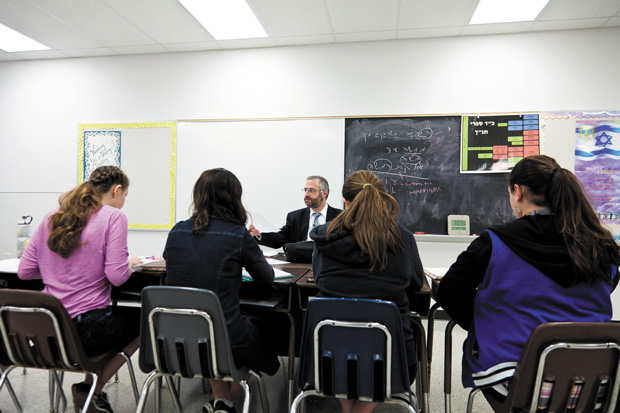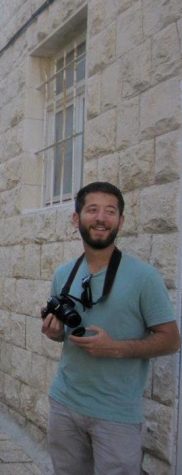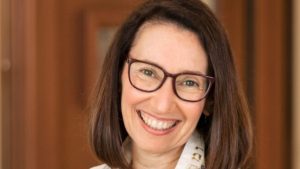St. Louis Jewish community split on school choice tax credit program
Rabbi Moshe Shulman teaches a class at Yeshivat Kadimah High School. Private religious schools in Missouri could benefit from a proposed tax credit program. Photo: Lisa Mandel
Published May 25, 2021
Missouri could soon have a tax credit program that would fund scholarships for students to attend private institutions, such as Jewish day schools. But not everyone in the St. Louis Jewish community supports the legislation.
The Missouri Empowerment Scholarship Accounts Program bill, which the state legislature approved earlier this month, would allow donors who give money to private organizations to receive tax credits, diverting money from public to private education. The program would offer a total of $50 million in tax credits for voucher-like scholarships but could grow to allow up to $75 million based on inflation. The program would allow more than 7,000 students to leave the public school system, according to an estimate from the Missouri Department of Elementary and Secondary Education.
Proponents describe it as a “school choice” measure that provides parents the options they need to ensure their children get a good education.
ADVERTISEMENT
Opponents say the legislation could violate the constitutional church and state separation by using tax dollars to support religious schools; would hurt school districts that already don’t have enough funding; and won’t improve overall student performance.
The House passed the legislation on an 82-71 vote; it passed in the Senate 20-13. The Republican sponsor of the House bill said he expects Gov. Mike Parson to sign it into law.
“I believe that our schools are struggling here in Missouri and that parents need choices and options,” said State Rep. Phil Christofanelli, R- St. Charles County. “This is a big win for Missouri students, and we are very excited to see it put into action.”
ADVERTISEMENT
Rabbi Shlomo Soroka, director of government affairs for Agudath Israel of Illinois, an Orthodox Jewish organization, advocated for the bill’s passage and described it as “a really great development for the St. Louis Jewish community.”
“A strong educational infrastructure for the Orthodox Jewish community is our lifeline,” said Soroka, former executive director of the St. Louis Kollel. “It brings in other families, and it can help the community grow and thrive.”
The National Council of Jewish Women St. Louis argues that students who receive such scholarships often have less success because they then attend private or home schools that do not have meet state standards for curriculum, testing and teacher qualifications, said Ellen Alper, CEO of the organization.
“It takes away money from public schools that low-income families rely on, and we believe that the focus should be on supporting underserved school districts, not taking money away from them,” said Alper.
In four states that implemented similar programs, students who used vouchers to attend private schools performed less well on tests than similar students who attended public schools, according to a 2017 report from the Brookings Institution, a Washington-based think tank.
Soroka and other school choice proponents discredit such studies by saying that the state assessments may not be a fair way of comparing private and public schools. In addition, they assert that the studies compare students who left failing districts for private schools with students in high-achieving districts, rather than a more relevant comparison against students in their former districts.
“The performance of public schools have improved with these types of programs because you can become a lazy monopoly when there is no competition, so if you care about kids, this is good for all kids,” said Soroka.
Proponents also say that the proposed program in Missouri has adjusted for mistakes made in similar programs in other states.
The legislation would only go into effect if the state provides a certain level of annual funding for school transportation and would allow school districts, for state funding purposes, to continue for five years to count voucher students, even if those students switched to private schools.
“Those are unique provisions that I don’t think exist anywhere else in school choice programs across the country and were the result of compromises that I made with opponents of the bill,” said Christofanelli.
While a majority of Republican lawmakers supported the legislation, there were some, like State Sen. Senator Lincoln Hough of Springfield, who voted against it.
In the state public school system, “there is always going to be room for improvement,” said Hough, whose parents were both educators. “What I don’t want to see is resources diverted from our public schools that are tasked with educating all those students [to] the handful who want to choose to take their kids someplace else and then leave fewer resources to educate the kids who are left at these schools.”
Rabbi Hershey Novack, co-director of the Chabad center at Washington University, supports the proposed program because it allows students in low-income neighborhoods to attend private schools that “give them a better chance,” he said.
“The system is completely broken. I don’t believe that a child who is born in Clayton and a child who is born in Wellston deserve completely different chances at a quality public education,” said Novack, whose children have attended public, Jewish and private secular schools.
Saul Mirowitz Jewish Community School, a pluralistic Jewish day school, does not support the program, according to Cheryl Maayan, head of school.
“If it were ethical to do so, we would gladly remove the obstacles that keeps Jewish families from choosing a Jewish day school for their children,” Maayan stated in an email. “Investing in a child’s Jewish education is the best way to strengthen their Jewish identity and ensure a vibrant Jewish future. That said, we also are raising our students to be socially responsible, to pursue justice and to care about others. It is not in keeping with our values to grow stronger at the expense of public education.”
















